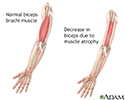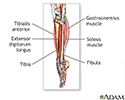Hand or foot spasms
Foot spasms; Carpopedal spasm; Spasms of the hands or feet; Hand spasmsSpasms are contractions of the muscles of the hands, thumbs, feet, or toes. Spasms are usually brief, but they can be severe and painful.
Considerations
Symptoms depend on the cause. They may include:
- Cramping
- Fatigue
Fatigue
Fatigue is a feeling of weariness, tiredness, or lack of energy.
 ImageRead Article Now Book Mark Article
ImageRead Article Now Book Mark Article - Muscle weakness
Muscle weakness
Weakness is reduced strength in one or more muscles.
 ImageRead Article Now Book Mark Article
ImageRead Article Now Book Mark Article - Numbness, tingling, or a "pins and needles" feeling
- Twitching
- Uncontrolled, purposeless, rapid motions
Nighttime leg cramps are common in older people.
Causes
Cramps or spasms in the muscles often have no clear cause.
Possible causes of hand or foot spasms include:
- Abnormal levels of electrolytes or minerals in the body
-
Brain disorders, such as Parkinson disease, multiple sclerosis, dystonia, and Huntington disease
Parkinson disease
Parkinson disease results from certain brain cells dying. These cells help control movement and coordination. The disease leads to shaking (tremors...
 ImageRead Article Now Book Mark Article
ImageRead Article Now Book Mark ArticleMultiple sclerosis
Multiple sclerosis (MS) is an autoimmune disease that affects the brain and spinal cord (central nervous system).
 ImageRead Article Now Book Mark Article
ImageRead Article Now Book Mark ArticleDystonia
Uncontrolled or slow movement is a problem with muscle tone, usually in the large muscle groups. The problem leads to slow, uncontrollable jerky mov...
 ImageRead Article Now Book Mark Article
ImageRead Article Now Book Mark ArticleHuntington disease
Huntington disease (HD) is a genetic disorder in which nerve cells in certain parts of the brain waste away, or degenerate. The disease is passed do...
Read Article Now Book Mark Article - Chronic kidney disease and dialysis
-
Damage to a single nerve or nerve group (mononeuropathy) or multiple nerves (polyneuropathy) that are connected to muscles
Mononeuropathy
Mononeuropathy is damage to a single nerve, which results in loss of movement, sensation, or other function of that nerve.
 ImageRead Article Now Book Mark Article
ImageRead Article Now Book Mark Article - Dehydration (not having enough fluids in your body)
- Hyperventilation, which is rapid or deep breathing that can occur with anxiety or panic
Hyperventilation
Hyperventilation is rapid and deep breathing. It is also called overbreathing, and it may leave you feeling breathless.
 ImageRead Article Now Book Mark Article
ImageRead Article Now Book Mark Article - Muscle cramps, usually caused by overuse during sports or work activity
Muscle cramps
Muscle cramps are when a muscle gets tight (contracts) without you trying to tighten it, and it does not relax. Cramps may involve all or part of on...
 ImageRead Article Now Book Mark Article
ImageRead Article Now Book Mark Article - Pregnancy, more often during the third trimester
- Thyroid disorders
- Too little vitamin D
- Use of certain medicines
Home Care
If vitamin D deficiency is the cause, vitamin D supplements may be suggested by the health care provider. Calcium supplements may also help.
Being active helps keep muscles loose. Aerobic exercise, especially swimming, and strength building exercises are helpful. But care must be taken not to overdo activity, which may worsen the spasms.
Drinking plenty of fluids during exercise is also important.
When to Contact a Medical Professional
If you notice recurrent spasms of your hands or feet, contact your provider.
What to Expect at Your Office Visit
The provider will perform a physical exam and ask about your medical history and symptoms.
Blood and urine tests may be done. Tests may include:
- Potassium, calcium and magnesium levels.
- Hormone levels.
Hormone levels
Blood or urine tests can determine the levels of various hormones in the body. This includes reproductive hormones, thyroid hormones, adrenal hormon...
 ImageRead Article Now Book Mark Article
ImageRead Article Now Book Mark Article - Kidney function tests.
Kidney function tests
Kidney function tests are common lab tests used to evaluate how well the kidneys are working. Such tests include:BUN (Blood urea nitrogen) Creatinin...
 ImageRead Article Now Book Mark Article
ImageRead Article Now Book Mark Article - Vitamin D levels (25-OH vitamin D).
25-OH vitamin D
The 25-hydroxy vitamin D test is the most accurate way to measure how much vitamin D is in your body. Vitamin D helps regulate calcium and phosphate ...
 ImageRead Article Now Book Mark Article
ImageRead Article Now Book Mark Article - Nerve conduction and electromyography tests may be ordered to determine if nerve or muscle disease is present.
Treatment depends on the cause of the spasms. For example, if they are due to dehydration, your provider will likely suggest you drink more fluids. Some studies suggest that certain medicines and vitamins may help.
References
Chonchol M, Smogorzewski MJ, Stubbs JR, Yu ASL. Disorders of calcium, magnesium, and phosphate balance. In: Yu ASL, Chertow GM, Luyckx VA, Marsden PA, Skorecki K, Taal MW, eds. Brenner and Rector's The Kidney. 11th ed. Philadelphia, PA: Elsevier; 2020:chap 18.
Francisco GE, Li S. Spasticity. In: Cifu DX, ed. Braddom's Physical Medicine & Rehabilitation. 6th ed. Philadelphia, PA: Elsevier; 2021:chap 23.
Jankovic J, Lang AE. Diagnosis and assessment of Parkinson disease and other movement disorders. In: Jankovic J, Mazziotta JC, Pomeroy SL, Newman NJ, eds. Bradley and Daroff’s Neurology in Clinical Practice. 8th ed. Philadelphia, PA: Elsevier; 2022:chap 24.
Muscular atrophy is the decrease in size and wasting of muscle tissue. Muscles that lose their nerve supply can atrophy and simply waste away.
Muscular atrophy
illustration
The muscles in the lower leg are divided into several compartments. The muscles in the anterior compartment include the tibialis anterior, extensor halluscis longus, extensor digitorum longus, and peroneous tertius. This group of muscle primarily extends the toes and dorsiflexes the ankle. When there is inflammation in the anterior compartment a painful condition called shinsplints can occur.
Lower leg muscles
illustration
Muscular atrophy is the decrease in size and wasting of muscle tissue. Muscles that lose their nerve supply can atrophy and simply waste away.
Muscular atrophy
illustration
The muscles in the lower leg are divided into several compartments. The muscles in the anterior compartment include the tibialis anterior, extensor halluscis longus, extensor digitorum longus, and peroneous tertius. This group of muscle primarily extends the toes and dorsiflexes the ankle. When there is inflammation in the anterior compartment a painful condition called shinsplints can occur.
Lower leg muscles
illustration
Review Date: 3/31/2024
Reviewed By: Joseph V. Campellone, MD, Department of Neurology, Cooper Medical School at Rowan University, Camden, NJ. Review provided by VeriMed Healthcare Network. Also reviewed by David C. Dugdale, MD, Medical Director, Brenda Conaway, Editorial Director, and the A.D.A.M. Editorial team.



